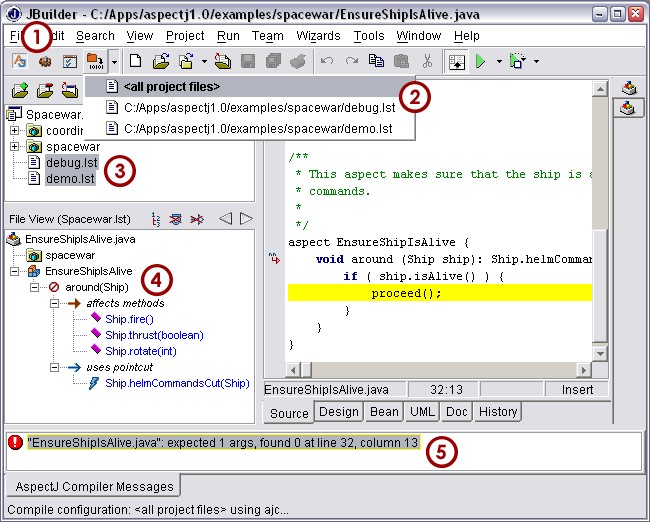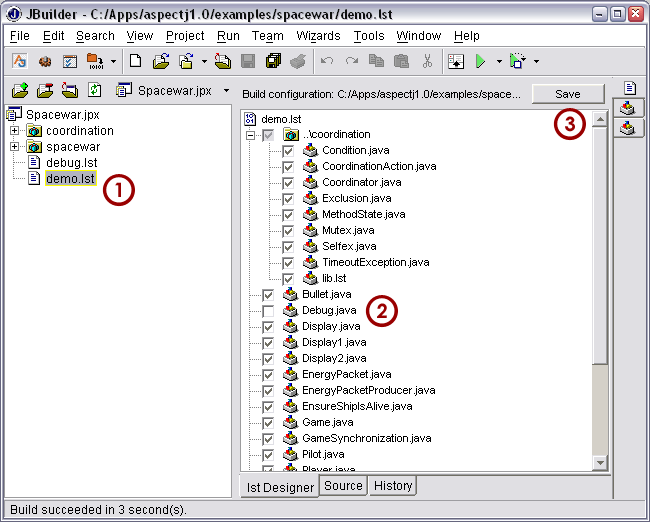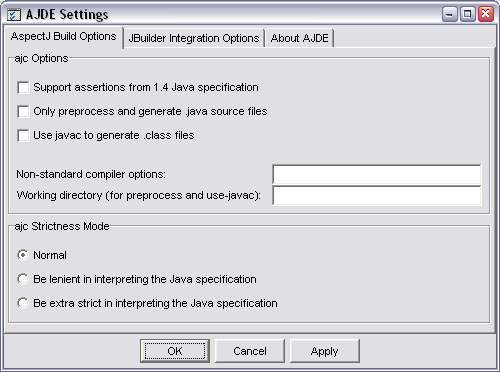AspectJ Development Environment (AJDE) support for JBuilder
Name
AspectJ Development Environment (AJDE) support for JBuilder — OpenTool extension Borland's JBuilder IDE.Overview
For release-specific documentation refer to the changes file.
AJDE for JBuilder will allow you to:
Installation and Project Setup
Install procedure: use the installer to place the "ajdeForJBuilder.jar" and "aspectjrt.jar" into JBuilder's lib/ext directory. This will also install the two html files "LICENCE-AJDEJBUILDER.html" and "README-AJDEJBUILDER.html".
Uninstall procedure: remove "ajdeForJBuilder.jar" and "aspectjrt.jar" (and the two html files, if you like) from the "lib/ext" directory.
Project setup: follow the normal procedure for JBuilder project setup (for an example of this please refer to the example below). However, note that all of the source files to be passed to the compiler must be added to your project either as files or within a package that is added to the project. This is necessary because -- unlike a pure Java compiler -- ajc does not search the SOURCEPATH for classes.

Starting and stopping AJDE: select "Start AJDE" in
the "AspectJ" section of the "Tools" menu, or just click on the "AJDE"
( ) button (label 1 in the first screenshot). This
will enable AJDE commands and will replace JBuilder's structure view
with the AspectJ Browser. To disable AJDE select "Stop AJDE" in the
same menu, or click the "AJDE" button again.
) button (label 1 in the first screenshot). This
will enable AJDE commands and will replace JBuilder's structure view
with the AspectJ Browser. To disable AJDE select "Stop AJDE" in the
same menu, or click the "AJDE" button again.
Compiling and Running the Project
To compile the project select "Build project with ajc" from the AspectJ toolbar, or click <ctrl>F11 while the editor pane is active. All of the files contained in your project and within any packages and subpackages that have been added to your project will be compiled. You may also select a different configuration (as with label 2 in the first screenshot). Then, structure of the currently visited file is shown (see label 3 in the first scrrenshot). If there is a compile error, the clickable error message is available (as with label 4 in the first screenshot).
To run the project select "Run Project" from the AspectJ toolbar, or click <ctrl>F12 while the editor pane is active.
Navigating the Program Structure

Navigation of program structure is provided by the AspectJ Browser, so apart from a JBuilder look and feel, the extra navigation AspectJ allows work as described there. In particular, you can use views with labels 1, 2 and 4 of the second screenshot to navigate structure using the blue links, and you can set filtering and navigate history using the toolbar shown by label 3 of the second screenshot.
Manipulating Build Configuration
Build configurations can be manipulated adding, removing, and editing build configuration files. The AspectJ Browser is used to select the current build configuration. Configurations are represented by ".lst" files which are described in the ajc documentation.

Adding and Removing Build Configurations
By default all of the files contained in your project and within any packages and subpackages that have been added to your project will be compiled. In order to compile a different configuration first add it to the project (by selecting "Add Files / Packages..." in the "Project" menu, and selecting the desired build configuration file (see label 1 in the third screenshot).
Example: Setting up the "Spacewar" Sample Project
To set up the Spacewar example first download it the examples distribution. Then
Select the location of the "aspectj/examples" directory for the project. This is because the Spacewar example uses both the "spacewar" and "coordination" packages, so we set up the project where it can get at both packages.
Choose a "jpr" project, either by typing in "Spacewar.jpr" as the project name, or by typing "Spacewar" as the project name and "jpr" as the type. Make sure "aspectj/examples" is still the directory for the project.
set the "Output path" entry to be the directory where you want your classes to go
set the "Output path" entry to be the directory where you want your classes to go
add "aspectjrt.jar" as a required library for the project. This library is located in "<jbuilder-install-directory>/lib/ext".
in the "Source" tab select the entry and click "Edit" (by default JBuilder will set this directory to be "examples/src" which does not exist)
in the leftmost pane you will notice "Spacewar.jpr", right click this and select "Add to project" in the popup, then "Add class/package..." in thenext popup. Or directly choose "Add files/packages".
<cntrl> select the "spacewar" and "coordination" packages and then click "OK"; this will add the two packages to your project
open the Structure View to browse the structure of the program
if you have not selected a class to run, you will be prompted to do so: select the class "spacewar.Game".
AspectJ related build options can be manipulated in the "AJDE settings" window

